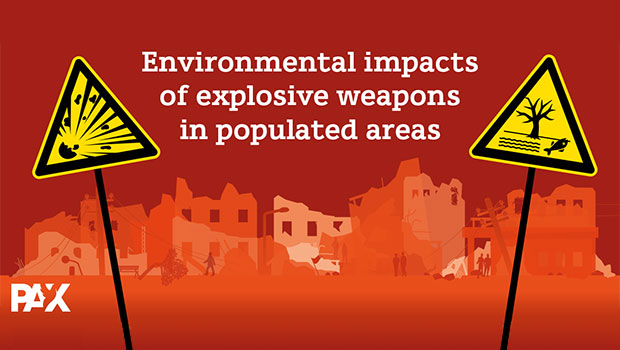This blog also appears on www.humanitariandisarmament.org
Introduction
In conflicts around the world, the use of explosive weapons in populated areas (EWIPA) is one of the greatest risks to civilians. Research by the British NGO Action on Armed Violence (AOAV) indicates that when these weapons are used in towns and cities 9 out of 10 victims are civilians. At the same time, conflicts in Iraq, Syria, Ukraine and Yemen have also demonstrated the wider impact of armed violence on environmental infrastructure and people depending on it.
This blog looks at the connection between the use of explosive weapons in populated areas and another field within the disarmament community where more attention is needed to improve the protection of civilians: the impact of conflict on the environment and how this affects lives and livelihoods of civilians.
The environmental dimension of armed conflicts is gaining more traction by states, international organizations and civil society groups. Conflict pollution can have serious acute and long-term health risks for populations, while damage to critical infrastructure can hinder access to clean water, worsen the spread of communicable diseases and result in toxic coping strategies for energy productions. There is also a growing recognition that the environment deserves a larger role in the post-conflict reconstruction phase. It can help building greener societies, while it is also an essential tool for de-escalation of tensions over scarce natural resources through peacebuilding.
The growing interest to address these concerns has been reflected through the work of the International Law Commission (ILC) on Protection of the Environment in Relation to Armed Conflicts, and the release of their 28 Draft Principles, United Nations Environment Assembly (UNEA) resolutions, the forthcoming update of the International Committee of the Red Cross’s (ICRC) Guidelines for Military Manuals and Instructions on the Protection of the Environment in Times of Armed Conflict, and recent discussions in the UN Security Council on the conflict-environment nexus. Recent reports of the UN Secretary General to the Security Council on Protection of Civilians underscored the linkages that require further work from the humanitarian community.
In many aspects of this area of work there is a need for better and more long-term data gathering through innovative means and methods such as open-source investigation and remote sensing, in order to better understand the environmental impact of conflict and consequent risks to civilians. Here, building on examples from the field, we explore the specific impact of explosive weapons use in towns and cities on the environment, as a way of guiding our thinking on data gathering efforts, better prevention and protection measures and post-conflict reconstruction.
Increasing the protection of civilians by avoiding the use of explosive weapons in populated areas and considering the environmental impact
Discussions around the use of explosive weapons in populated areas focuses both on the characteristics of explosive weapons as well as the context of use. It refers to a broad category of weapons that all project blast and fragmentation around the point of detonation. A populated area is widely understood to be an area with a high concentration of civilians. Most problematic when used in populated areas are those explosive weapons that have a wide area effect. In a town, it is likely that civilians will be wounded and killed, houses destroyed and essential infrastructure damaged, resulting in a complex and interrelated pattern of harm.

In the last decade states, international organizations and civil society gathered in the International Network on Explosive Weapons have convened multiple times in the run up to a political declaration to better protect civilians against the impact of explosive weapons in populated areas. To have an impact on the ground, PAX calls for this political declaration to commit states to avoid the use of explosive weapons in populated areas because of the direct and indirect impact on civilians and their environment. Due to the COVID-19 crisis international meetings are postponed, but a political declaration is expected to be negotiated as soon as the pandemic allows the process to be continued.
Environmental impacts from military activities can be classified as direct and indirect. Direct impacts are defined by Jensen & Lonergan (2012) as everything from toxic hazards from damaged industrial sites and urban infrastructure to hazardous war remnants and the loss of Water Sanitation and Health (WASH) facilities, among other things. Indirect pathways link to unstainable coping mechanisms such as makeshift oil refining, deforestation for fuel needs, and poor resource governance. The direct environmental impact is most relevant to the discussion around the use of explosive weapons and their acute and long-term health risks for citizens and their communities.
Through our work in around 15 conflict areas around the world, PAX has conducted field research into explosive weapons use in populated areas, as well as the relation between conflict and environment. There are direct connections between the issues that can provide insights on the effects of explosive weapons and environmental harm that impacts lives and livelihoods of civilians, which are relevant to the current political discussion around EWIPA.
Direct environmental impact: case studies
“When I opened my eyes it was like there was flour everywhere in the air, it was white, I couldn’t see anything. It was like very thick fog”.
–Lyudmilla (58) describes how a rocket landed in her apartment block in Eastern Ukraine.

There are clear cases of the direct impact of explosive weapons on the environment for people. Sometimes this impact is a result of the inherent characteristics of explosive weapons: for example, an explosive weapon will project blast and fragmentation around the point of detonation, often causing buildings to collapse and debris to fly around. Because of the blast pressure, small particles will be projected into the air, and inhaled by civilians directly present, or clearance workers removing the conflict rubble. Pulverized building materials potentially contain toxic substances like asbestos or metals which will be inhaled and be open in the environment with potential health risks this brings along. There are also indications, based on reports from wound contamination of military veterans and patients in conflict zones and laboratory research, that heavy metal toxicity linked with debris and shrapnel contamination in armed conflicts can be linked with antimicrobial resistance. Reports from an increase of antibiotic resistance among patients in the densely populated city of Mosul, northern Iraq, warrant further research.
Sometimes the environmental impact is related to the context of populated areas, where water and sanitation infrastructure is crucial for proper health conditions. In conflicts in Syria, Yemen and Iraq, damage to environmental infrastructure has resulted in the destruction of WASH facilities and diminishing access to clean water and sewage systems. This has contributed to large outbreaks of communicable diseases such as cholera in urban environments, affecting millions of civilians.
Another problem is when industrial sites are located in populated areas. Industrial sites often contain chemicals and other toxic substances that may leak into the environment as result of an attack. This may affect drinking water quality, quality of the soil and crops or lead to direct exposure to chemical substances. Recent examples include the Mishraq Sulphur Factory in northern Iraq set on fire by the so-called Islamic State, or the looming environmental catastrophe in Donbas in eastern Ukraine, where multiple chemical facilities are at acute risk of being targeted. An entire region may become uninhabitable due to polluted surface and groundwater.
Indirect environmental impact: case studies
In some cases the environmental impact will be more indirect, more long-term, less visible and the impact on the health of civilians may be less straightforward.

For example, when explosive weapons are being used in towns and cities, they risk leaving behind Explosive Remnants of War (ERW). Research indicates that toxic substances such as lead, mercury or depleted uranium may leak into the ground, or lead to direct exposure by civilians working with military scrap metal, and accumulation over term could result in significant health problems. There are also risks from munitions constituents: acute exposure to military toxics in propellants from rockets and missiles, and chronic exposure to explosive materials such as TNT, RDX and HMX can pollute soils and water and create long-term risk for civilians. Current discussions in the US around remediation of firing ranges highlight the risk for nearby communities through leaking of energetic materials. Intense and sustained use of explosive weapons in conflicts can also cause an accumulation of munition constituents, and therefore studies are warranted on soil contamination in post-conflict contexts to understand these risks.
Another pathway of exposure for civilians is conflict rubble and debris that can get mixed with industrial, medical or household waste, thereby creating health risks. Dealing with these types of conflict rubble in cities such as Mosul in Iraq, or Aleppo and other cities in Syria has increased awareness among donors and international organizations to include these considerations in post-conflicts responses. A secondary environmental impact of large-scale urban destruction is the way reconstruction is set up, in particular the extraction of natural resources for building materials. As was noticed by the United Nations Environment Programme (UNEP) in Lebanon after the 2006 war, and in Iraq after the liberation of Mosul in 2017, the rise of (illegal) quarries to excavate sand and stone for building materials resulted in the abandonment of villages as people could not reach the groundwater anymore. More generally in Iraq there is significant destruction of local ecosystems and water pollution from river quarries on the Tigris riverbeds.
Conclusion and recommendations
Whether the environmental impact of EWIPA is direct, or indirect, short term or long term, the high presence of civilians in populated areas will make it likely that large numbers of civilians will be affected. New research insights into conflict pollution and on how military toxics can contribute to civilian exposure, warrants reconsideration of military planning cycles, targeting decisions and support for post-conflict remediation efforts through clearance of toxic remnants of war. Increased support from international organizations such as the International Committee of the Red Cross, UN bodies such as United Nations Environment Assembly, and the International Law Commission and discussion in the UN Security Council underscores the importance of this topic.
We therefore call upon states and other parties to conflict to consider foreseeable environmental impact in military planning and operations. The discussions on the political declaration to strengthen the protection of civilians from civilian harm from the use of explosive weapons in populated areas constitutes a chance to integrate environmental considerations in both data gathering and military planning cycles.
Furthermore, more data should be collected in those areas where the environmental impact may be expected, but where no credible data is available to support this yet. Proper identification and assessment of targeted urban areas can help understand the wider environmental security risks and can already be implemented with current open-source investigative research and remote sensing approaches. The information collected can be shared with relevant humanitarian response organizations and authorities to minimize further exposure and ensure rapid clean-up and monitoring of affected areas.
Thirdly, the environmental impact should be better integrated into mine-action and clearance operations, as currently is promoted by demining organizations and civil society groups. These novel approaches include proper environmental impact surveys, disposal methods and minimizing the impact of clearance organizations.
Lastly, we strongly urge states to include environmental considerations and concerns into the wider discussions on environment, peace and security, be it in fora such as the UN General or Environmental Assembly and the UN Security Council, in debates with donors on post-conflict reconstruction priorities or in ongoing engagements with legal processes such as the ILC and dialogues with the ICRC around the updated Military Guidelines on the environment.




